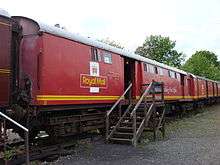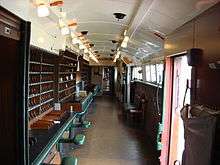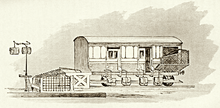Travelling Post Office


A Travelling Post Office (TPO) was a type of mail train used in Great Britain and Ireland where the post was sorted en route. The last Travelling Post Office services were ended on 9 January 2004, with the carriages used now sold for scrap or to preservation societies.
Carriage of mail by train
Following an agreement in 1830, made between the General Post Office and the Liverpool and Manchester Railway (L&MR), mail had been carried by train in Great Britain, between Liverpool and Manchester, via the L&MR.[1] The passing of the Railways (Conveyance of Mails) Act 1838 required railway companies to carry mail, by ordinary or special trains, as required by the Postmaster General; however, this act did not set the charges for such services.[1]
These special trains eventually became Travelling Post Offices (TPOs). TPOs were employed in many British Commonwealth countries;[2] and the Army Post Office had its own TPOs.
TPOs were equipped with letter boxes so that mail could be posted whilst the train stood at a station. The post-marks from TPOs are valued by philatelists.
History

Mail was first sorted on a moving train in January 1838, in a converted horse-box, on England's Grand Junction Railway. It was carried out at the suggestion of Frederick Karstadt, a General Post Office surveyor.[3] Karstadt's son was one of two mail clerks who did the sorting.[4] In 1845 the service was extended via Derby to Newcastle upon Tyne by the Midland Railway; and soon after reached Scotland.[5]
The first special postal train was operated by the Great Western Railway between London and Bristol. The inaugural train ran on 1 February 1855, leaving Paddington station at 20:46, and arriving at Bristol at 00:30. In 1866, apparatus for picking up and setting down mailbags without stopping was installed at Slough and Maidenhead.
In 1963 (the year of the Great Train Robbery) there were 49 mail trains, with one to five TPOs attached to passenger trains, and complete TPO trains between London and Aberdeen and Penzance.[6]
Post-privatisation of British Rail
After the privatisation of British Rail in the mid 1990s, British TPOs were operated by Rail Express Systems and their successor EWS. Royal Mail decided to suspend all transportation of mail by rail in 2003.[7] The last TPO services went out on the night of 9 January 2004,[8][9] ending the sorting of mail on trains in the UK.[10]
However, Royal Mail did restore the movement of some already-sorted letters by rail in time for the Christmas season that year, contracting with EWS's competitor GB Railfreight to resume bulk transfer services along the West Coast Main Line between its mail terminals at London (Willesden), Warrington and Glasgow (Sheildmuir) using the dedicated Class 325 electric multiple units that had been in operation since 1996. In 2009 the contract for these mail trains was transferred to EWS's successor DB Schenker Rail. For flexibility Royal Mail had preserved rail access to its distribution centres on Tyneside (Low Fell) and at Tonbridge in Kent,[7] and did occasionally send mail trains to Low Fell, for example when Newcastle Airport was closed by snow.[11] In June 2013, a regular service resumed from Low Fell.
Ireland
Early TPOs began to appear on Irish trains in 1855, though general post-carrying vehicles had been around since the early days of the Dublin and Kingstown Railway.
In 1958, Coras Iompair Eireann built four modern TPOs for Department of Posts and Telegraphs at their Inchicore Works. Some time before their withdrawal it had been decided that two would be dedicated to use on the Cork Mail and two to the Galway Mail, both of which originated from Connolly station in Dublin. The movement of post by rail in Ireland ended in 1992.
Two of the 1958-built TPOs survived into preservation- 2977 of the Cork Mails and 2978 of the Galway Mails. Both are at the Downpatrick and County Down Railway, who own 2978, whilst 2977 is still owned by An Post.
Preservation
Several Royal Mail TPO's have been preserved along with stowage vans and GUV's. Only one PCV (Propelling Control Vehicle) remains, currently at the Mid-Norfolk Railway. At these preservation lines you can see the TPO's performing a live drop off/pick up from a preserved line side apparatus. The Great Central Railway and the Nene Valley Railway[12] are leading this endeavour with many weekends devoted to 'Mail by Rail'. Other lines are following in their wake so there are many places you can see these vehicles in action.
TPO vehicles
TPOs were formed of several different types of vehicle:
See also
- Great Central Steam Railway - where the Travelling Post Office and Mail Exchange on the Move is recreated
- Great Train Robbery (1963) in which £2.3 million was stolen from a Glasgow to London TPO train
- Night Mail - Film and poem about Travelling Post Office
- Railways (Conveyance of Mails) Act 1838
- Railway post office - North American term for cars that served similar functions.
- SNCF TGV La Poste - French Post Office dedicated TGV sets.
- British Rail Class 325, Royal Mail EMUs used in Britain.
- London Post Office Railway, that Royal Mail used to transport mail across London on private underground tracks.
- Nene Valley Railway, where visitors can ride the TPOs and get off at a remote exchange point to watch the mail pickup/drop off.
References
- 1 2 Simmons, Jack; Biddle, Gordon (1997). The Oxford Companion to British Railway History From 1603 to the 1990s (1st ed.). Oxford: Oxford University Press. ISBN 0-19-211697-5. Pp 303-304.
- ↑ Poole, L.G. (1969). "The Travelling Post Offices of Victoria: 1865 - 1912", In: Australian Railway Historical Society Bulletin, June, 1969, Pp127-139.
- ↑ White, John H. (1978). The American Railroad Passenger Car. Baltimore, MD: Johns Hopkins University Press. p. 473. ISBN 0801819652. OCLC 2798188.
- ↑ Johnson, Peter. (1985). The British Travelling Post Office. Surrey: Ian Allan Publishing. p. 13. ISBN 0-7110-1459-0.
- ↑ Billson, P., (1996) Derby and the Midland Railway Derby: Breedon Books
- ↑ Railway Magazine September 1963 p. 661
- 1 2 Written statement by Royal Mail Archived 29 June 2011 at the Wayback Machine. (Document FOR 105), House of Commons Transport Select Committee, September 2003
- ↑ Daily Mirror 10 January 2004 "Send of the line - last journey by mail trains"
- ↑ "What happened to the TPOs?". British Postal Museum & Archive. Retrieved 7 January 2014.
- ↑ BBC Cumbria Jan 2004
- ↑ Railforums posting, 29 December 2010
- ↑ "The Night Mail Museum". Nene Valley Railway Museum and Educational Charity. Retrieved 6 December 2016.
Further reading
- Cooper, Basil (July 1983). "The TPO story". Rail Enthusiast. EMAP National Publications. pp. 41–45. ISSN 0262-561X. OCLC 49957965.
External links
- The Travelling Post Office, British Postal Museum and Archive
- Travelling Post Offices, Allan Yeo website.
- Parcels and Post Office Traffic, Mike Smith 'Goods and Not So Goods' website.
- Mail by Rail, John Chenery 'Light Straw' website.
- Friends of M30272M TPO Group, Nene Valley Railway (via archive.org)
- Schedule of mail trains operating from London (Willesden) in 2002
- TPO and Seapost Society for all collectors of Rail and Ship Mail worldwide
- Winchester, Clarence, ed. (1 March 1935), "Travelling Post Offices", Railway Wonders of the World, pp. 157–162 , an account of Travelling Post Offices in the 1930s